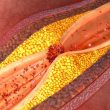Courtesy of Dr. Carlos Fava. The risk of repeat surgical mitral valve repair involves 6% to15% mortality at 30 days, even close to 20% in acute cases. However, mortality can rise to over 40% when it comes to a third or fourth surgical intervention. One of the solutions to this serious problem is transcatheter mitral...
Plaque Morphology Could Modify Functional Measurements
The vulnerable features of plaque are independently associated to functional measurements done under hyperemia far better than baseline measurements such as iFR. These findings suggest that not only stenosis severity but also plaque features contribute to functional measurements. This is a sub-study of the PACIFIC (Prospective Comparison of Cardiac PET/CT, SPECT/CT Perfusion Imaging and CT...
Routine Continuous Monitoring After Angioplasty Might Not Be Necessary
According to a recent study published in Circ. Cardiovasc Interv, after a scheduled angioplasty, the rate of arrhythmia requiring some kind of treatment is very low, low enough to deem unnecessary the routine monitoring of all patients. The standard policy at many institutions is continuous cardiac monitoring for several hours after undergoing coronary angioplasty, with...
Alcohol and Atrial Fibrillation: More Reasons for Moderate Consumption
Reducing alcohol consumption should be included in the “package” of secondary prevention recommendations, not only for its impact on arteries, but also because it reduces atrial fibrillation (AF). Alcohol abstinence might improve arrhythmia symptoms and reduce the chances of recurrence in patients who have already had an episode of AF. Regular alcohol consumers who were...
New European Guidelines for Dyslipidemia Management: What is New?
Reading clinical practice guidelines, except for specific consultation, is usually tedious. These guidelines are nor meant to be read as a textbook, or at least this is what most readers believe. But it looks like this reader’s perception has finally been acknowledged, hence “table 3” in the new European dyslipidemia guidelines, where the new recommendations,...
Pre-TAVR Revascularization: Angiographic or Physiological?
In patients undergoing transcatheter aortic valve replacement (TAVR), fractional flow reserve (FFR) guided revascularization is associated with favorable results compared against the traditional angiography guided revascularization. Given the complete lack of randomized studies, this observational study is the best we have to decide how to guide revascularization in patients with symptomatic severe aortic stenosis undergoing...
The Road Towards a “More Perfect” Angioplasty Is Already Being Traveled
The aim of revascularization, whether through angioplasty or surgery, is to restore adequate flow to the myocardium; that much is obvious. However, after millions of “successful” procedures with the best technology applied to drug-eluting stents and optimal medical treatment, we still have a high ratio of patients who experience new events. Could an optimal angiographical...
Prosthesis Mismatch in Supra and Intra Annular valves
The self-expandable valve was associated to lower prosthesis-patient mismatch (PPM) compared against the balloon expandable valve regardless annular area, according to this study soon to be published in J Am Coll Cardiol Intv. This difference was basically driven by patients with larger body surface area (>1.83m²). Prosthesis mismatch has been associated to increased mortality after transcatheter...
Drug Coated Balloons vs. Drug Eluting Stents in Primary PCI
There might come the time when we are finally able to leave nothing behind, at least in the context of primary PCI. The REVELATION study, soon to be published in J Am Coll Cardiol Intv, has shown that paclitaxel coated balloons resulted non inferior to drug eluting stents (DES) in terms of FFR (fractional flow...
The Most Read Articles of August in solaci website
1-FDA Expands TAVR Indication to Low-Risk Patients Both the self-expandable valve Evolut R and its direct competitor, balloon-expandable valve Sapien 3, received the authorization to be indicated for low-risk patients in a long-awaited announcement made on August 16th, 2019. Read also HERE 2-Mechanisms of Post PCI Persistent Angina Angina persistence or recurrence after PCI can...









